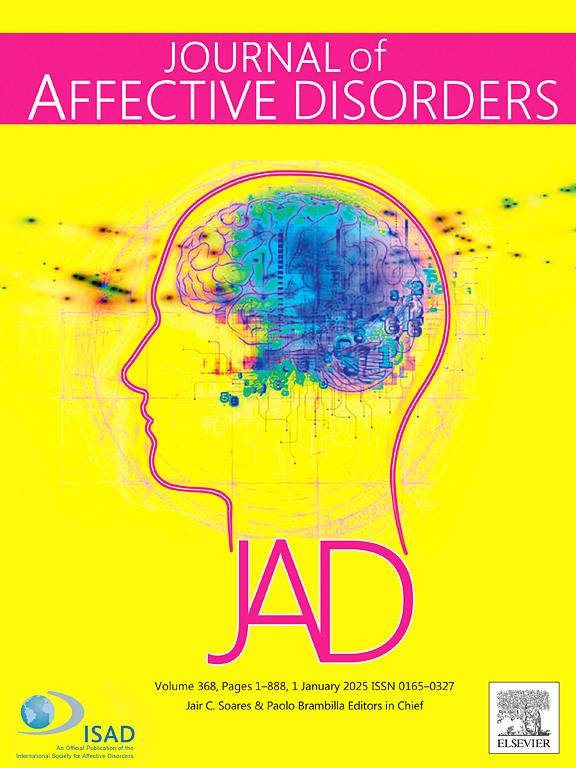改善心理健康综合征的特异性:抑郁表型的基于投影的聚类。
IF 4.9
2区 医学
Q1 CLINICAL NEUROLOGY
引用次数: 0
摘要
背景:为提高综合征特异性而进行的定量尝试通常会产生大量异质性亚组,从而影响治疗和研究目标的有效性。评估现有方法有效应用的障碍,并从可解释的基于投影的聚类替代方案中检查改进,可能会提高我们研究目标和分类系统的精度和可重复性。方法:本探索性横断面研究于2018年11月至2023年7月期间从澳大利亚初级卫生保健服务机构招募了2820名年龄在12至25岁 的参与者,其中1843名参与者完成了相关的抑郁、焦虑和躁狂样经历的自我报告测量,并被纳入分析。主成分分析(PCA)用于检验证内方差的分布。将基于预测的亚型与传统的定量表型分析方法进行比较:聚类范式(基于模型的,基于中心的分区,分层),LCA和探索性因子分析(FA)。结果:与所有其他方法相比,基于可解释投影的聚类改善了聚类之间的均匀性和定性区别。这确定了14个集群,可分为6个新的症状特征:睡眠(n = 117;11 %),躁狂症(n = 125;12 %),焦虑(n = 119;11 %),体重/食欲增加(n = 138;13 %),体重/食欲下降(n = 242;23 %)和未分化类型(n = 310;29 %)。PCA发现了一个偏斜的幂律分布在症状方差之下,影响了标准的LCA/聚类程序。这与优化算法相互作用,产生异质亚型。在FA中,它产生了HiTOP研究中确定的嵌套层次结构。结论:偏态方差分布对标准聚类/LCA方法有不利影响。因此,未来的研究应该考虑其对优化算法的影响,或者使用更具体的基于投影的聚类。确定的概况反映了抑郁症状表达的主要趋势,潜在地代表了改进的研究目标。本文章由计算机程序翻译,如有差异,请以英文原文为准。
Towards improved specificity in mental health syndromes: projection-based clustering of depressive phenotypes
Background
Quantitative attempts to improve syndrome specificity typically produce large heterogenous subgroupings, impacting the validity of treatment and research targets. Assessing barriers to the valid application of existing methods and examining improvements from an interpretable projection-based clustering alternative may improve the precision and reproducibility of our research targets and classification systems.
Methods
This exploratory, cross-sectional, study recruited 2820 participants aged 12-to-25 years, from primary-healthcare services in Australia, between November 2018 and July 2023. 1843 participants completed relevant self-reported measures of depression, anxiety and mania-like experiences, and were included for analysis. Principal Component Analysis (PCA) was used to examine the distribution of within-syndrome variance. Projection-based subtypes were compared to traditional quantitative phenotyping approaches: clustering paradigms (Model-Based, Centre-Based Partition, Hierarchical), LCA, and Exploratory Factor Analysis (FA).
Results
Interpretable projection-based clustering improved homogeneity and qualitative distinctions between clusters were compared to all other methods. This identified 14 clusters organisable into six novel symptom profiles: sleep (n = 117; 11 %), mania (n = 125; 12 %), anxiety (n = 119; 11 %), weight/appetite gain (n = 138; 13 %), weight/appetite loss (n = 242; 23 %), and an undifferentiated type (n = 310; 29 %). The PCA identified a skewed power-law distribution underlying symptom variance, affecting standard LCA/clustering procedures. This interacted with optimisation algorithms, producing heterogenous subtypes. Within FA, it produced the nested hierarchical structure identified in HiTOP studies.
Conclusions
A skewed variance distribution underlying the depressive syndrome adversely impacts standard Clustering/LCA methods, and may contribute to past difficulties in identifying well-specified data-driven phenotypes. Consequently, future studies should consider the distribution's impact to their optimisation algorithms or use the better-specified projection-based clustering. Identified profiles reflect major trends in depressive symptom expression, potentially representing improved research targets.
求助全文
通过发布文献求助,成功后即可免费获取论文全文。
去求助
来源期刊

Journal of affective disorders
医学-精神病学
CiteScore
10.90
自引率
6.10%
发文量
1319
审稿时长
9.3 weeks
期刊介绍:
The Journal of Affective Disorders publishes papers concerned with affective disorders in the widest sense: depression, mania, mood spectrum, emotions and personality, anxiety and stress. It is interdisciplinary and aims to bring together different approaches for a diverse readership. Top quality papers will be accepted dealing with any aspect of affective disorders, including neuroimaging, cognitive neurosciences, genetics, molecular biology, experimental and clinical neurosciences, pharmacology, neuroimmunoendocrinology, intervention and treatment trials.
 求助内容:
求助内容: 应助结果提醒方式:
应助结果提醒方式:


